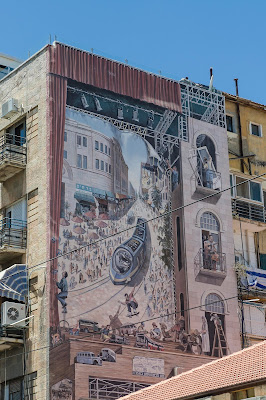As exciting as a field excavation can be, it is
also a very taxing endeavour. So halfway through the season, the volunteers and
the staff get a long weekend off to unwind a little bit. This year, the
destination for most of them was the Holy city: Jerusalem.
 |
| Dome of the Rock. THE landmark that characterizes the old city |
As a place of religious importance to the three
great monotheistic religions, Jerusalem is a city with an interesting dynamic.
The Old City, confined within walls that have been torn down and rebuilt a
dozen times, is bound by a strict set of rules ranging from who can live where
to what type of stone you must use to build or renovate in the city. There are
four well-defined quarters for various religions, yet they all seem to merge
fine within the crowded streets. The streets themselves busy and noisy but
follow a side street and you end up in a small square or patio that is all but
deserted.
Compared to the Old City, the New City appears
to be worlds apart at first glance. Whereas you have to barter fiercely with
shop owners to avoid being ripped off in the souk, the New City is all about
the price tags and attempting to barter is not considered funny. The limestone
and plaster within the walls is a far cry from the concrete and glass of the
postmodern architecture outside. In the evening the Old City closes down for
the night, whereas bright spots of bars and hangouts light up in the New City.
Yet there are some similarities to be found between both the city within the
walls and the one outside of them. The Old City is considered to be at the heart
of culture, but the New City is littered with galleries and street art
throughout, putting it on equal footing in terms of cultural diversity.
Furthermore, life in both sections seems to run more on people time, rather
than clock time. Both areas are also equally suited if you enjoy ‘people
watching’. Just sit down on a crossroad or square with some coffee and watch
the broad plumage of humanity that calls the city home, whether it is only for
a few days, or for the rest of their life.
 |
| Celebrating the building of the light rail |
Jerusalem has a very particular charm to it.
The bells of the churches and the adhan
of the mosques sounding at the same time have the appearance of a shouting
match, with each trying to outdo each other. This is just one example of why Jerusalem
seems like a surreal paradox: it is a city wrought by conflict since the first
time someone decided it would be nice to have a wall around the place, but also
a crossroad of many cultures that share more similarities than some wish to
admit. It is a city of both spirituality and trade, of old and new, of habibi’s
and enemies, of peace and violence. It is a history that can be read on the
visage of the city and the people that live in it.
 |
| Umbrella installation. Both beautiful and functional |
But more than its sights or sounds, I will
always remember Jerusalem by its scents and smells. The Old City is a giant
souk and as such it gives one the impression of walking through clouds of
scents at every new street and shop. The bouquet ranges from the sugary sweet
smell of candy to the nauseating stench of meat going bad. The New City smells like
the hot steel of the light rail on Jaffa street. It smells of the sweat of
volunteers taking a wrong turn and making a scorching detour along the
sun-baked streets. It smells of strawberry slushies that are the perfect treat
after a long hot walk. It smells of freshly ground coffee and of melting
chocolate in the corner store. It smells of hookah smoke on a balmy night
outside the Damascus gate. It smells like a vacation.
Signing off
Geen opmerkingen:
Een reactie posten